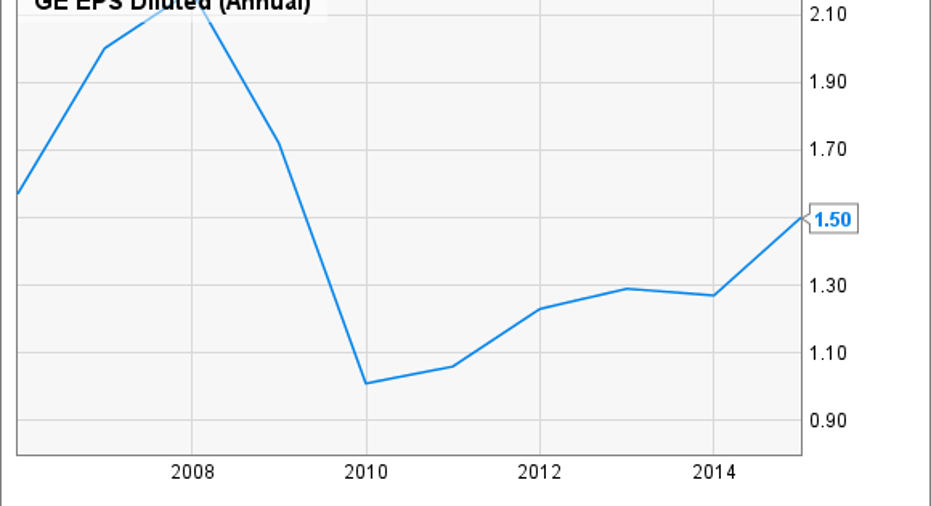The Best General Electric Company Headlines in 2015

Without question, 2015 has been a huge year for General Electric . The industrial giant announced a historic deal to divest the majority of its financial services business, it completed the largest acquisition in its history, the stock has been beating the S&P 500 by a wide margin, and the company attracted a large investment from a well-regarded activist investor. Suffice it to say, the media and analyst community has been quite busy following all the moves that GE has been making to transform itself into a leading digital industrial company.
While there is much progress to be made before the transformation is complete, the following three headlines were some of GE's biggest moments in 2015.
The divestment heard around the worldSince the 2008 financial crisis, GE's earnings per share has struggled to recover, weighed down by the anemic performance of its massive financial services business, GE Capital, which made up 42% of GE's operating earnings in 2014.
GE EPS Diluted (Annual) data by YCharts.
As the above chart illustrates, it's become increasingly difficult for GE to generate acceptable returns for its large financial services company since the crisis, not to mention, it diverts the company's focus and resources away from its core industrial businesses.
In light of these developments, management announced a plan last April to divest the majority of GE Capital -- assets that don't support its underlying industrial activities, over the next 24 months, and return the excess capital to shareholders in the form of buybacks, dividends, and share exchanges. Not including the $75 billion Synchrony Financial exchange, approximately $200 billion in assets will be sold off as part of the plan. Through Dec. 9, GE has announced $149 billion in asset sales outside of the Synchrony exchange.
Ultimately, GE's goal is to create a more streamlined, simplified General Electric, where 90% of its operating earnings come from industrial activities in 2018. Not only will this move make GE almost entirely industrial focused, but it will also reduce the balance sheet's exposure to financial shocks.
Alstom closesAfter months of concessions and regulatory scrutiny, GE got the go-ahead to acquire Alstom's power and grid segments for $10.3 billion last month. Competitively speaking, Alstom's expertise in steam power generation, as well as its leadership in renewable energy, including offshore solutions, allows GE to better compete in the worldwide global power market. Combining Alstom's steam technology with GE's gas technology means that GE now has the capability to create the world's most efficient and complete power plant solution in the world.
The acquisition also gives GE a greater market share in emerging markets and expands its power generation installed base to the largest in the world. The latter creates a sizable opportunity to sell higher-margin long-term service contracts.
All told, management believes that Alstom will be a significant earnings driver for the company over the next five years, generating $3 billion in annual cost savings and synergies and growing the unit's earnings by approximately 15% per year. In other words, the Alstom growth story appears to be just getting started.
Bye-bye to SIFIAfter the financial crisis, U.S. regulators deemed GE Capital to be a systematically important financial institution, or SIFI, because they considered it to be so important to the economy that its failure could result in a widespread crisis of its own. Essentially, the SIFI designation put GE Capital among the "too big to fail" banks and placed stricter capital requirement on it than non-SIFIs.
Although there isn't anything inherently wrong with being a SIFI, GE has considerably less flexibility in how it allocates capital than it industrial peers that aren't also involved in the financial services industry. Ultimately, these higher capital requirements could be viewed as a competitive disadvantage.
But as GE Capital shrinks, the need for it to maintain its SIFI designation greatly diminishes. As noted earlier, GE has already lined up buyers for $149 billion of the $200 billion in assets it's pledged to sell to exit the financial services game. This should go a long way in helping make GE's case to remove its SIFI designation, when it appliesfor the removal in the first quarter of 2016. If successful, it would free up excess capital, giving it the ability to make greater investments into its business and return more capital to shareholders.
Looking ahead: execution in focusJudging by GE's 2015 stock performance, the market appears to be embracing its decision to return to its industrial roots and distance itself from the financial services business. With the road map squarely in place, it now becomes a matter of how well GE can execute on this massive undertaking. After all, a plan only becomes a success story after it's been properly executed. GE still has its work cut out for it.
The article The Best General Electric Company Headlines in 2015 originally appeared on Fool.com.
Steve Heller has no position in any stocks mentioned. The Motley Fool owns shares of General Electric Company. Try any of our Foolish newsletter services free for 30 days. We Fools may not all hold the same opinions, but we all believe that considering a diverse range of insights makes us better investors. The Motley Fool has a disclosure policy.
Copyright 1995 - 2015 The Motley Fool, LLC. All rights reserved. The Motley Fool has a disclosure policy.